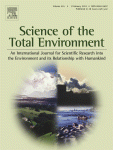Science of The Total Environment 417-418
Overview of new articles on POPs in a new issue of the Science of The Total Environment journal.

Carcinogenic potencies of polycyclic aromatic hydrocarbons for back-door neighbors of restaurants with cooking emissions
Pages 68-75
Jein-Wen Chen, Shu-Li Wang, Dannis Paul Hsientang Hsieh, Hsi-Hsien Yang, Hui-Ling Lee
- Twenty-one PAHs congeners were measured in the stack outlet of 20 restaurants. The total B[a]Peq concentrations were found highest in Chinese-type restaurant. The ILCRs were 8.3–29.3, 4.1–14.8, 3.5–13.2 × 10− 6 in Chinese, Western, BBQ restaurants. The acceptable exposure time for Chinese restaurant was 7–21 h month− 1.
Transfer of PBDEs and chlorinated POPs from mother to pup during lactation in harp seals Phoca groenlandica
Pages 98-107
Héloïse Frouin, Michel Lebeuf, Mike Hammill, Michel Fournier
- Significant variations in contaminant distribution patterns were observed between seal tissues of mothers and pups. The selectivity in the transfer of POPs between mothers and pups appeared mainly driven by their log Kow. The most selective transfer step for the POPs examined occurred between the blubber and the serum of the mother. The offloading of contaminants via lactation constitutes a major but selective excretory route for reproductive female seals. The offloading of contaminants via lactation constitutes also a significant route of exposure for suckling pup seals.
PCBs and OH-PCBs in polar bear mother–cub pairs: A comparative study based on plasma levels in 1998 and 2008
Pages 117-128
Jenny Bytingsvik, Elisabeth Lie, Jon Aars, Andrew E. Derocher, Øystein Wiig, Bjørn M. Jenssen
- We examined plasma levels of PCBs and OH-PCBs in polar bear mothers and their cubs.Levels of PCBs and OH-PCBs were lower in 2008 compared to in 1998 (Svalbard). he maternal transfer of OH-PCBs was lower than for PCBs. Cubs seem to have a lower capacity to biotransform PCBs to OH-PCBs than mothers. Levels in cubs were above levels associated with health effects in humans/wildlife.
Concentrations and speciation of polybrominated diphenyl ethers in human amniotic fluid
Pages 294-298
Mark F. Miller, Sergei M. Chernyak, Steven E. Domino, Stuart A. Batterman, Rita Loch-Caruso
- 21 BDE congeners were measured in amniotic fluid samples from fifteen women. The average total PBDE concentration was 3795pg/ml amniotic fluid. The average total PBDE concentration ranged from 337 to 21,842pg/ml. BDE-47 and BDE-99 were identified in each sample of human amniotic fluid. BDE-208, 209, 203, 206, 207, and 47 were the most abundant BDEs in amniotic fluid.
15.2.2012




